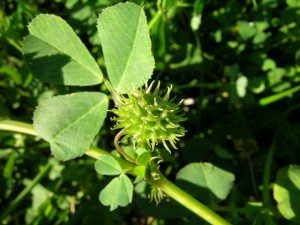How Invasive Plant Life Thrive in Droughts and Displace Native Species

Associate Biology professor Casey terHorst
From shrinking glaciers to extreme heat waves to droughts and invasive plant species, global climate change is not only having a damaging effect on the environment, it’s also costing the U.S. economy billions of dollars.
California State University, Northridge’s associate professor of biology Casey terHorst has studied the effects of droughts on invasive plant species for eight years. In his studies, he analyzes how drought conditions might affect how well those plants invade.
terHorst’s research primarily involves working with Medicago polymorpha, one of several invasive plant species found in California which has invaded from the Mediterranean region. However, the majority of the invasive species found throughout the state’s four regions come from Asia, South America and Europe, through unintentional human exportation of goods from around the world.
terHorst findings reveal that these invaders don’t seem to mind the drought and fare the same in wet conditions as they do in dry. Native plants like sage and California lilacs, however, suffer from the drought, suggesting that dry conditions might facilitate the invasion by some plants.
“The primary thing I’m concerned with, is how invasive species displace native species,” said terHorst. “In California for example, it’s becoming really hard to find many native plants, now the most common species we find in nature are often invaders like burr clovers, [Medicago polymorpha] star thistles and non-native grasses.” he said.

Medicago Polymorpha (Burr Clover)
Burr clovers are often the most common invasive plants found on hillsides, grasslands and wildlands throughout California. This clover is identifiable by the small fruit that it makes, which are either spiky or round.
“The big research project we have going on now is in preparing a bunch of individuals [burr clovers] we’ve collected from places where the plant has already invaded and comparing them with other individuals from the native range,” said terHorst. “In a greenhouse, we grow them with different watering levels so they either get all the water they want, or they’re exposed to drought conditions where we’ll let the plants dry out a bit before we water them again. This simulates what a drought would look like in California.”
The issue with the influx of invasive plant species is the effect it has on the landscape. Changes in plant populations are becoming a common sight, causing a sort of rapid evolution among the environment and plant life.
“In the case of rapid evolution, population changes that once occurred over millions of years, now happen in a much shorter time frame due to climate change,” said terHorst. “So, what happens is, say you have a bunch of different individuals [plants] with different traits and then a drought occurs. Only the individuals who are good at dealing with drought make it, passing those characteristics of drought tolerance to the next generation.”
As a result, native wildlife habitats are beginning to be negatively impacted through this rapid change in the landscape. In a state common for wildfires, vegetation will often re-sprout vigorously and rapidly, increasing the dangers of wildfires that can degrade the food and water supply of these creatures.
In an article published by the USA Today in 2018, it was reported that California spent $114 million fighting fires in July alone. This was estimated to be a quarter of the fire-related budget for the year, with officials anticipating worsening days to come.
“We’re starting to see climate change affect the day-to-day life of people in California,” said terHorst. “Increasing wildfires in the state are no longer in remote areas but are now burning entire towns and killing lots of people,” he said.
As drought conditions worsen across California, terHorst believes that many native plant species are in danger of being driven extinct. He is hopefully however, that through a united effort native plant species can be restored.
“There’s a lot we can do just around our own houses,” said terHorst. “Planting native plants in our backyards is a big and simple way to reintroduce native species back into the environment. This alone, can go a long way.”
To learn more about terHorst research on invasive plant species, please visit his website at: http://www.ecoevolab.com/research/

 experience
experience